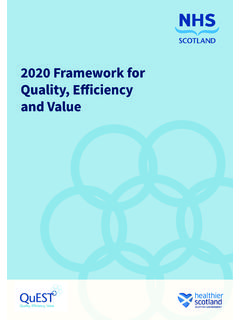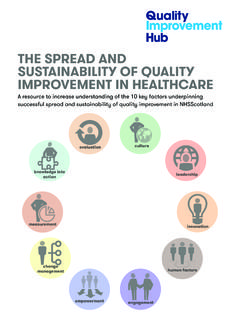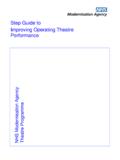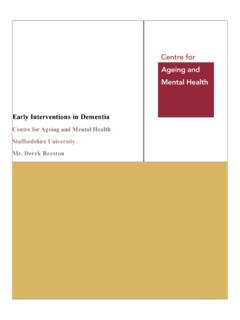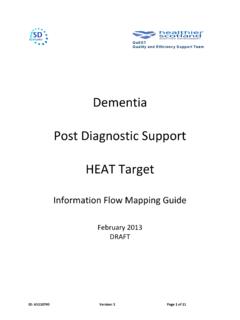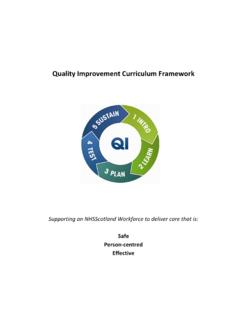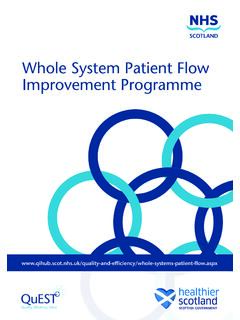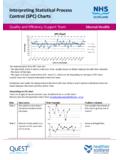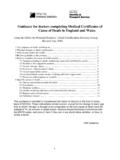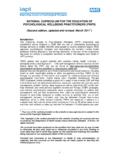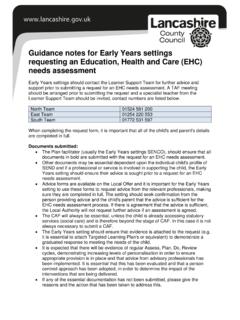Transcription of WISEMAN WORKLOAD MEASURE GUIDANCE NOTES 1.0 …
1 WISEMAN WORKLOAD MEASURE . GUIDANCE NOTES . WHAT IS THE WISEMAN WORKLOAD MEASURE . The WISEMAN WORKLOAD MEASURE (WWM) is a tool that measures actual and total WORKLOAD . Within the tool, total WORKLOAD is defined as Direct Care, Indirect Care, Role/Agency Tasks and Travel'. The tool is completed by individual practitioners and can be aggregated to represent team and service total activity and total capacity. The WISEMAN WORKLOAD MEASURE was originally devised in 1992 and has been used successfully by multi-disciplinary and multi-agency staff working in Community Mental Health Teams (CMHT) for adults and older people. The tool has been audited and updated several times and has proved to be valid and reliable in all settings WHAT ARE THE MEASURES.
2 The WWM describes total WORKLOAD in four sections. These are:- Direct Care Indirect Care Role/Agency Tasks Travel. These elements were derived originally through study and audit of Community Psychiatric Nursing Activity. Since then they have been shown to accurately explain and MEASURE the total WORKLOAD of any community practitioner. The Direct Care, Indirect Care and Role/Agency Tasks sections are referred to as the Professional Elements of the total WORKLOAD DIRECT CARE. Direct Care describes the element of WORKLOAD that involves face to face contact with the service user. Frequency and duration of face-to-face contacts provide an accurate MEASURE of service user dependency. The Direct Care section of the WWM identifies the frequency and duration of contacts for each service user on a caseload and incorporates a MEASURE for group activities such as depot clinics, therapy groups etc.
3 Thus, individual and cumulative levels of dependency are confirmed. Effective management of capacity and demand requires a balance between turnover (admission and discharge) and dependency. INDIRECT CARE. Indirect Care describes all service user related tasks that do not involve face-to-face contact with the service user such as documentation, liaison, carer support and case reviews etc. Frances M WISEMAN 2010 Page 1 of 6. WISEMAN WORKLOAD MEASURE . GUIDANCE NOTES . ROLE/AGENCY TASKS. The Role/Agency tasks section measures the amount of time required for other duties necessary for service delivery and development and continuous, professional maintenance and development. Some examples are staff meetings, management tasks, education, supervision of self and others and special projects.
4 TRAVEL. Travel can be associated with any of the other three sections. Defining the amount expended on each section does not add value to the information supplied therefore it is measured as the full amount required for the total WORKLOAD . The calculation for travel used in the WWM was established from recorded travel time statistics over a period of 6 months. The calculation has been tested on five occasions and has been found to represent an accurate, average per hour mileage for urban and rural travel. WORKLOAD AND SERVICE MANAGEMENT. Under usual circumstances the WWM is completed once per month. The information logged is derived from a complete, random, working week from the four weeks prior to the date of completion.
5 A single record does not provide definitive facts and figures however, over time cumulative records supply an accurate description of actual WORKLOAD and WORKLOAD management. Service/team capacity and demand can be identified by aggregating the information from individual WWMs. If circumstances dictate the WWM can be used more frequently. It is open to the individual user to decide the most appropriate frequency for purpose. RELATIONSHIP BETWEEN THE WORKLOAD ELEMENTS. The relationships between the three professional elements of the WWM are shown below. Individual recordings will illustrate peaks and troughs but failure to demonstrate these ratios over time indicates that the practitioner may be concentrating on one element of WORKLOAD to the detriment of the other elements.
6 It should be noted that these ratios only apply where the core purpose of a post is direct service delivery. Direct Care to Indirect Care ratio is 2:1. every 60 minutes of direct care will require 30 minutes of indirect care Direct Care + Indirect Care to Role/Agency Tasks is 2:1. every 90 minutes of Direct + Indirect Care will require 45 minutes of Role/Agency Tasks Frances M WISEMAN 2010 Page 2 of 6. WISEMAN WORKLOAD MEASURE . GUIDANCE NOTES . ALTERATIONS TO THE RELATIONSHIP OF THE WORKLOAD . ELEMENTS. Where the core purpose of the post is not direct service delivery then the ratios may be different to that quoted above and the user will need to establish the correct ratios through comparison of measures over time. For example, the core purpose of some posts, particularly in Older People's Services is weighted towards care or case management.
7 Such posts will show a higher level of Indirect Care and a lower level of Direct Care so the ratio is likely to be reversed. The core purpose of posts should be clarified before the WWM is applied so that the applicable ratios are explicit for all users. Please contact the copyright holder if you require further GUIDANCE . In addition to the above, if a direct care practitioner is undertaking a substantial course of education or training or is involved in a significant project then there may a temporary change to the ratio of Direct + Indirect Care to Role/Agency Tasks. INFORMATION OUTCOMES. Traditionally caseload numbers have determined WORKLOAD estimates despite the fact that caseload numbers are known to be an ineffectual MEASURE of anything other than numbers.
8 The usefulness of the WWM is the versatility of the measures that allow the user to capture total WORKLOAD even in circumstances where the WORKLOAD content has altered. For example, when training or project work is added to the WORKLOAD the overall commitment is immediately measured, quantified and evidenced within the Role/Agency Tasks section. The combined outcomes for all sections of the WWM define actual, total WORKLOAD and provide reliable evidence on which to base WORKLOAD management, service management and decision-making. SUPERVISION/REFLECTION. The WWM provides a legitimate basis for discussion and reflection within the supervision process and includes a Turnover and Time-On-Caseload Monitor to enhance its value as an aid to supervision/reflection.
9 The caseload profile and WORKLOAD information obtained using the WWM combined with the Turnover and Time-On-Caseload Monitor serve to increase practitioners' awareness of their styles of and approaches to care delivery and management. The supervisor also gains more insight into practitioners' practice. Using the WWM practitioners are able to describe and justify individual styles of therapeutic contact. For instance, a high number of weekly contacts may illustrate intense contact with high turnover which is consistent with caseloads of around 20. service users over time. Equally, less frequent contact with average turnover is consistent with caseloads of 20-30 service users over time but can produce the same therapeutic outcomes and deal with the same number of service users over a given Frances M WISEMAN 2010 Page 3 of 6.
10 WISEMAN WORKLOAD MEASURE . GUIDANCE NOTES . time period. High dependency service users are likely to require intense contact with low turnover which is consistent with caseload numbers of around 10-15 over time. The WWM also enables practitioners and supervisors to identify quickly issues that may be disruptive to WORKLOAD management. For example a high number of weekly contacts with low turnover and caseload numbers of 25-30 will immediately be demonstrated as demand exceeding capacity. The level of excessive demand will be quantified. The caseload can be capped and the need for such a high frequency of contact with little movement in the caseload can be explored. A continuing care caseload that demonstrates high weekly contact over long periods with little movement towards less frequent contact and minimal turnover may indicate that care plans require review.
